|
a
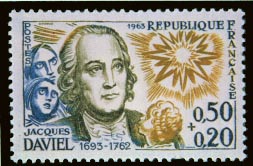 |
Jacques Daviel is a ophthalmic surgeon in the 18th century who developed
new techniques for the extraction of cataract and had
published extensively on the subject. |
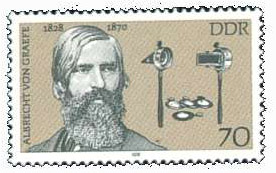 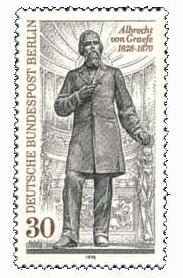 |
| Albrecht von Graefe, famous German ophthamologist is one of the pioneer
of modern ophthalmology. For more information visit Doyne's Hall of Fame
for more information. |
Stamps commemorate the 3rd Mediterranean Day on Rheumatology
and 9th Congress of the International Society of Geographic
Ophthalmology featuring Prof. Hulusi Behcet.
Behçet's disease or syndrome (Hulusi Behçet, Turkish dermatologist,
1889-1948): A multi-system disease of unknown cause, seen
particularly in young males, characterized by mucous membrane
ulceration, iridocyclitis with hypopyon, recurrent pyoderma, arthralgia,
thrombophlebitis and neurologic abnormalities. |
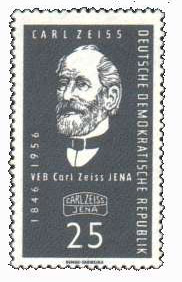 |
| Carl Zeiss is a well-known German instrument maker. He designed a number
of ophthalmic instruments which are still in use nowadays. |
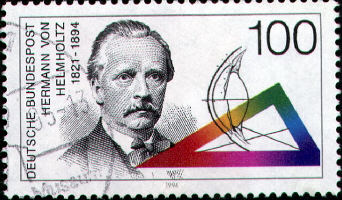
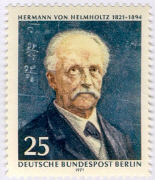 |
| In 1850, Hermann von Helmholtz (1821-1894) inaugurated the modern era
in ophthalmology with his invention of the ophthalmoscope, which has done
more to revolutionize the development of ophthalmology than any other invention
or discovery. Before Helmholtz's invention, it was not possible to visualize
the posterior pole of the eye in a living subject.
The ophthalmoscope permitted the clinical correlation of signs and symptoms
with findings in the retina, vitreous, and optic nerve. The ophthalmoscope
became the model for all forms of endoscopy that followed. It is often
compared in importance with 2 earlier inventions, the telescope (17th century)
and the stethoscope (early 19th century). All of these instruments made
dramatic new information available to the human mind.
- from Archie of Ophthalmology - |
 |
| David Hubel, USA and Torsten Wiesel, Sweden, got the 1981 Nobel Prize
for their work on the information processing in the system of vision. |
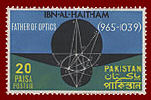 |
| Abu Ali al'hasan ibn al'Haitam is known in the West as Alhazen, born
in 965 in Persia and died in 1039 in Egypt. He is called the Father of
Optics for his writings on and experiments with lenses, mirrors, refraction
and reflection. He correctly stated that vision results from light that
is reflected into the eye by an object, not emitted by the eye itself and
then reflected back, as Aristotle believed. He solved the problem of finding
the locus of points on a spherical mirror rom which light will be reflected
to an observer. From his studies of refraction he determined that the atmosphere
has definite height, and that twilight is caused by refraction of solar
radiation from beneath the horizon. |
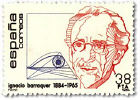 |
| I. Barraquer 1884-1965. The web site where this stamp came from was
in Spanish. I wonder if he was related to the LASIK pioneer? |
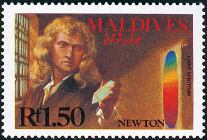 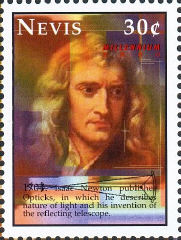
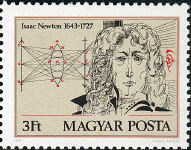 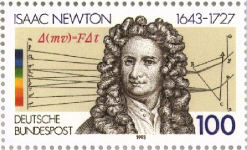 |
| Widely regarded as the father of the physics of light and optic. Issac
Newton had contributed greatly to our understandings of light and colours. |
 |
| Percy Lavon Julian (11th April 1899 - 19th April, 1975 ) synthesized
physostigmine for treatment of glaucoma and cortisone for the treatment
of rheumatoid arthritis. His other inventions included a fire-extinguishing
foam for gasoline and oil fires.
Born in Montgomery, Alabama, the grandson of a former slave, Julian
had limited schooling because Montgomery provided no public education for
blacks after the eighth grade. He entered DePauw University in Greencastle,
Indiana, as a 'sub-freshman' and, though ill-prepared, graduated in 1920
as class valedictorian with Phi Beta Kappa honours. Advised against pursuing
a graduate education because of his race, Julian went to Fisk University
to teach chemistry. In 1923, with an Austin Fellowship in Chemistry, he
earned a master's degree from Harvard University.
After teaching at West Virginia State College and Howard University,
Julian received his Ph.D. in organic chemistry from the University of Vienna
in 1931. He returned to DePauw University, where his international reputation
was established in 1935 by synthesizing physostigmine, a drug treatment
for glaucoma, from the calabar bean.
Despite scientific acclaim, DePauw University denied him a professorship
because of his race. During the next 17 years, Julian was director of research
at the Glidden Company, a paint and varnish manufacturer. He developed
a commercial process for isolating and preparing soya bean protein, which
could be used to coat and size paper, to create cold water paints, and
to size textiles. During World War II Julian used soya protein to produce
'AeroFoam'-a substance that suffocates gasoline and oil fires.
Julian went on to synthesize the female and male hormones, progesterone
and testosterone, by extracting sterols from soybean oil. He was noted
most for his synthesis of cortisone, used in the treatment of rheumatoid
arthritis and other inflammatory conditions. His synthesis reduced the
price of cortisone from hundreds of dollars per drop for natural cortisone
to a few cents per gram.
- from San Francisco Society of Ophthalmology - |
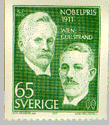 |
| ALLVAR GULLSTRAND (1862--1930), picture on the right, was professor
of physiological and physical optics at the University of Uppsala: the
Nobel Prize winner in Physiology or Medicine "for his work on the dioptrics
of the eye." |
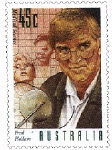 |
Fred Hollows.
Born in NewZealand, but lived in Australia. He was a famous
Eye Surgeon of Sydney Hospital. He believed in equality and
founded total ophthalmic care services for the Aborigines. He
was known as "Wild Colonial Boy". He established eye
centres in Nepal and Africa for the poor. FredHollows Eye
Foundation was established in his name. The main work is to
manufacture Quality IOL in low price. The Fred Hollows IOL
Lab. |
|
|